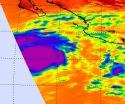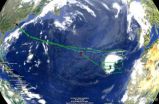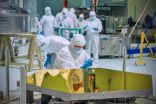(Press-News.org) TALLAHASSEE, Fla. — A Florida State University chemist's work could lead to big improvements in our ability to detect and eliminate specific toxins in our environment.
Featured on the cover of the prestigious Journal of the American Chemical Society (JACS), Sourav Saha's specialized work to strip electrons from the toxic chemical known as fluoride is producing a variety of unique results.
"I started out with the very basic premise of trying to find new ways to detect toxic fluoride in solutions," said Saha, an assistant professor of chemistry at Florida State. "As I got further into that work I was able to create a compound that could actually strip the electrons right off the molecule, producing a variety of tangible benefits such as toxin detection and removal."
Saha's initial fluoride-detection work led to a $100,000 grant from the Petroleum Research Foundation to further explore the possibilities of his research. Using that money, he was able to bring in additional expertise and build his "fluoride-robbing" compound that is the central feature of the work featured on the JACS cover.
"This work is very exciting and novel because the results are surprising," said Timothy Logan, chairman of the Department of Chemistry and Biochemistry at Florida State. "Molecules always have affinity for electrons, with some molecules having a greater affinity than others. Flouride has the highest electron affinity of all, so the ability to strip off electrons from fluoride, especially in the presence of other molecules with lower electron affinity, is truly unique."
Although Saha is excited about the possibilities of his new compound in toxin cleanup, he sees a huge variety of potential applications for his research.
"I think toxin removal is one of the most obvious and relatable benefits my work could lead to, but in reality, there are many additional implications this work could have on daily life," Saha said. "For instance, we could develop this research to create all new types of plastics that could exhibit unique qualities, or improve the effectiveness of devices, such as batteries, that are used to store and transfer energy."
###
To read more about Saha's work in the JACS, visit http://pubs.acs.org/doi/abs/10.1021/ja303173n. To learn more about Saha, visit http://www.chem.fsu.edu/bio.php?id=838.
Florida State University, rated RU/VH ("Research University/Very High" research activity) by the Carnegie Foundation for the Advancement of Teaching, is one of the nation's leading research and creative-activity institutions. With nearly $204 million in external research funding in 2011 and a large collection of unique, cutting-edge scientific and performing arts facilities, Florida State offers faculty and students unparalleled opportunities to expand the frontiers of knowledge and discovery in their areas of expertise. To learn more about Florida State research, locate a subject matter expert or arrange an interview on a specific research or creative topic, contact Tom Butler at tbutler@admin.fsu.edu or Florida State's News and Research Communications Office at (850) 644-4030.
CONTACT: Tom Butler, University Communications
(850) 644-8634; tbutler@admin.fsu.edu END
Florida State University chemist may hold key to building a better toxin mousetrap
2012-09-25
ELSE PRESS RELEASES FROM THIS DATE:
Treating ovarian cancer: New pathways through genetics
2012-09-25
This press release is available in French.Montreal, September 24, 2012 – A new discovery that sheds light on the genetic make up of ovarian cancer cells could explain why some women survive longer than others with this deadly disease. A multi-disciplinary team led by the Research Institute of the McGill University Health Centre (RI MUHC), in collaboration with the Lady Davis Institute of the Jewish General Hospital and the University of Montreal Hospital Research Centre, has identified genetic patterns in ovarian cancer tumours that help to differentiate patients based ...
Exposing cancer's lethal couriers
2012-09-25
Malignant cells that leave a primary tumor, travel the bloodstream and grow out of control in new locations cause the vast majority of cancer deaths. New nanotechnology developed at Case Western Reserve University detects these metastases in mouse models of breast cancer far earlier than current methods, a step toward earlier, life-saving diagnosis and treatment.
A team of scientists, engineers and students across five disciplines built nanochains that home in on metastases before they've grown into new tissues, and, through magnetic resonance imaging, detect their locations. ...
White matter, old dogs, and new tricks at Dartmouth
2012-09-25
Most people equate "gray matter" with the brain and its higher functions, such as sensation and perception, but this is only one part of the anatomical puzzle inside our heads. Another cerebral component is the white matter, which makes up about half the brain by volume and serves as the communications network.
The gray matter, with its densely packed nerve cell bodies, does the thinking, the computing, the decision-making. But projecting from these cell bodies are the axons—the network cables. They constitute the white matter. Its color derives from myelin--a fat that ...
Bone marrow holds secrets for treating colitis and Crohn's
2012-09-25
EAST LANSING, Mich. — Michigan State University researchers have unlocked secrets in bone marrow that could lead to improved treatments for colitis and Crohn's disease.
The results, featured in the current issue of Proceedings of the National Academy of the Sciences, show that the havoc inflammatory bowel diseases wreaks on the digestive tract is mirrored in bone marrow. Early indications also show that the disorders of the gut could potentially be treated through the bone marrow, said Pam Fraker, MSU University Distinguished Professor of biochemistry and molecular biology.
"It's ...
MRI helps identify patients with prostate cancer who may benefit from active surveillance
2012-09-25
Philadelphia, PA, September 24, 2012 – PSA screening has resulted in improved prostate cancer survival, but the high rate of diagnosis and treatment side effects raise concerns about overtreatment. In the quest to prevent overtreatment, "active surveillance" has emerged as a plausible option, encouraged for men whose tumors may not need immediate treatment and may never progress to more serious illness. Appropriate criteria for selecting patients for active surveillance are continuously debated. A group of investigators from Memorial Sloan-Kettering Cancer Center in ...
Feeling guilty versus feeling angry -- who can tell the difference?
2012-09-25
When you rear-end the car in front of you at a stoplight, you may feel a mix of different emotions such as anger, anxiety, and guilt. The person whose car you rear-ended may feel angered and frustrated by your carelessness, but it's unlikely that he'll feel much guilt.
The ability to identify and distinguish between negative emotions helps us address the problem that led to those emotions in the first place. But while some people can tell the difference between feeling angry and guilty, others may not be able to separate the two. Distinguishing between anger and frustration ...
Yale researchers call for specialty metals recycling
2012-09-25
New Haven, Conn. -- An international policy is needed for recycling scarce specialty metals that are critical in the production of consumer goods, according to Yale researchers in Science.
"A recycling rate of zero for specialty metals is alarming when we consider that their use is growing quickly," said co-author Barbara Reck, a research scientist at the Yale School of Forestry & Environmental Studies.
Specialty metals, which include rare earth elements such as indium, gallium and germanium, account for more than 30 of the 60 metals in the periodic table. Because ...
NASA's satellite saw 'power-trigger' around Hurricane Miriam's center
2012-09-25
ASA's Aqua satellite revealed a large area of powerful thunderstorms around the center of Tropical Storm Miriam on Sept. 23 as it tracked through the Eastern Pacific Ocean. That power was the trigger that helped Miriam rapidly intensify into a major hurricane on Sept. 24.
NASA's Aqua satellite passed over the eastern Pacific Ocean on Sept. 23 and the Atmospheric Infrared Sounder (AIRS) instrument captured an infrared image of Tropical Storm Miriam's cloud top temperatures. Tropical Storm Miriam is born that day, about 640 miles (1,025 km) south-southeast of the southern ...
NASA's Global Hawk and satellites see tropical storm Nadine turning around
2012-09-25
Tropical Storm Nadine is turning around in two ways. When NASA's Global Hawk flew over the storm it learned that the storm was not transitioning into an extra-tropical storm. Now, NASA satellites see that Nadine is physically turning its direction, and heading back to the west-northwest and away from land.
The fifth science flight of NASA's Global Hawk concluded when the aircraft landed at NASA's Wallops Flight Facility, Wallops Island, Va. on Sunday, Sept. 23 after flying over Tropical Storm Nadine in the Eastern Atlantic Ocean. The Hurricane and Severe Storms Sentinel ...
First 2 Webb Telescope flight mirrors delivered to NASA
2012-09-25
The first two of the 18 primary mirrors to fly aboard NASA's James Webb Space Telescope arrived at NASA's Goddard Space Flight Center in Greenbelt, Md.
The mirrors are going through receiving and inspection and will then be stored in the Goddard cleanroom until engineers are ready to assemble them onto the telescope's backplane structure that will support them.
Ball Aerospace, Boulder, Colo., under contract to Northrop Grumman, is responsible for the Webb's optical technology and lightweight mirror system. On September 17, 2012, Ball Aerospace shipped the first two ...




